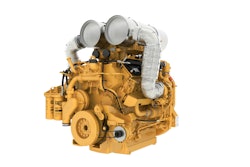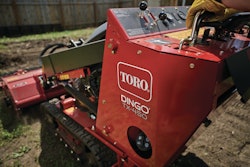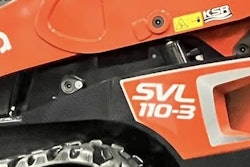At one time, many contractors felt compact excavators in the 2.5- to 3-metric-ton weight class were incapable of providing cost effective or efficient productivity compared to the full-sized models, but no longer. In 2005, there were nearly 25,000 compact excavators retailed in the United States and about 25 brands marketing more than 160 models.
Make no mistake, the compact excavator will never replace the digging capacity of the full-sized models – most compact excavators in the 2.5- to 3-metric-ton class have a dig depth of only 7 to 9 feet – and you will still see the full-sized excavators digging basements and large trenches, but alongside them will be the compact excavators doing the precision work such as digging trenches for utility and gas lines. Where at one time it was a machine with limited use, it has now become a common sight on many work sites.
“It was a machine that a lot of dealers and rental companies were renting, but it wasn’t a mainstay,” says Mike Ross, product manager for Takeuchi. “It wasn’t a machine that was sought after as a part of a fleet. Today it’s the complete opposite. Most contractors have at least one compact excavator in their fleet.”
There are a few reasons for this change of heart. According to Ross, contractors have become educated about the abilities of this machine. In addition, the residential construction sites where the 2.5- to 3-metric-ton compact is seeing the most use are getting smaller, while the houses are getting bigger.
“As today’s jobsites become more tight, the equipment used becomes more compact,” says Bill Anderson, product manager for Volvo. “Many sites require close trenching to buildings or retaining walls. The compact excavator can maneuver into places a larger machine can’t get to. Performance will overcome machine size in many applications.
Heavy-duty lightweights
Compact excavators in this class have engines that average about 24 horsepower and booms that can swing right or left in ranges from 50 degrees to 90 degrees. The machine’s 3,600- to 5,000-pound range breakout force and multifunction hydraulics give operators fast cycle times and impressive digging force. High-efficiency, torque-limiting piston pumps help advanced hydraulics deliver more usable power by continuously responding to loads. These abilities make the compact excavator more nimble than other machines in some situations.
“The house on a compact excavator can continuously rotate 360 degrees,” says Tom Connor, product manager for Bobcat. “This allows for enhanced spoil placement, superior visibility and reduces repositioning for work in tighter spaces.”
Many models have little or no tail swing, providing an added benefit to how and where you can use this machine.
“With the zero-tail swing units, you can pull right up next to a building, dig a trench right next to it, and swing the excavator to dump the dirt without the house or the tail hitting the wall or whatever obstruction you are right up next to,” says Bill Gearhart, assistant marketing manager for Yanmar.
There’s a trade-off to the zero-tail swing however. Zero-tail swing models often have a wider track gauge than conventional models, which can cut down on movement through restricted access areas.
But compact excavators in general are attractive to contractors because they are heavy enough to get the job done, but light enough not to disrupt their environment. Matt Mumford, industry manager for Caterpillar’s North America compact excavator line, says the “lighter weight of the compact means it is easier to transport.” In most states, compact excavators in the 2.5- or 3.5-metric-ton range are the maximum you can you can tow behind a 2-ton pickup. Compact excavators leave less of a footprint on sites that require light ground pressure or have existing utility lines and fixtures that can be damaged.
“It just depends on what you are doing,” says Ross. “I think compact excavators are more cost effective than a backhoe, especially with the limited amount of damage it will do on a worksite compared to the ruts a tractor loader backhoe will put into existing property.”
And then there are fuel costs. It will cost much more to run a full-sized excavator than it will to run a compact excavator in the same time period. And there is no need for an oversized trailer or a special license to haul it.
The right tool for the job
So how do you know which compact excavator and attachments to choose? The answer can be as simple as understanding what your needs are and how your goals can be accomplished. As you are searching for the right compact for your work site, there are a few fundamental specs to think about.
“When a customer is looking at a compact excavator between 2.5 to 3 tons, usually machine size, weight and digging depth are important specs,” says Tom Connor, compact excavator product specialist for Bobcat.
But if you are not sure what type of machine you need, the easiest way is to ask the experts for tips.
“The customer should work with his local dealer to ensure he is matching the correct machine to his requirements,” Mumford says. “Most dealers are willing to arrange a rental or demo on the jobsite prior to purchase of the machine.”
And don’t forget the attachments available for the compact excavator, including hydraulic thumbs, hydraulic breakers, trenchers, augers, grading buckets and blades, plate compactors and trenching buckets.










